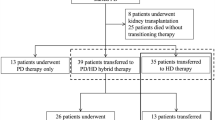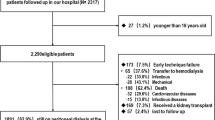Abstract
Background
The prevalence of obesity is increasing worldwide. Obesity is also increasing in the chronic kidney disease (CKD) population. There are conflicting data on complications such as mortality, peritonitis, and technique proficiency of peritoneal dialysis (PD) in underweight and obese patients according to body mass index (BMI). We aimed to present the data in our region to the literature by comparing the residual renal function (RRF), peritonitis, technique proficiency, and mortality rates of the patients we grouped according to BMI.
Methods
The data of 404 patients who were started and followed up in our clinic between March 2005 and November 2021 were evaluated retrospectively. They were grouped as underweight, normal weight, overweight, and obese according to BMI. RRF, mortality, technique proficiency and peritonitis data of the groups were compared.
Results
Of the 404 patients, 44 were underweight, 199 were normal weight, 110 were overweight, and 55 were obese. No difference was found between the groups in the technique survey and in the time to first peritonitis with Kaplan–Meier analysis (respectively; p = 0.610, p = 0.445). Multivariate Cox regression analysis showed that BMI did not affect mortality (HR 1.196 [95% CI 0.722–1.981] (p = 0.488)).
Conclusion
In conclusion, we report that BMI has no effect on RRF, peritonitis, technique proficiency, and mortality in patients undergoing PD, and that mortality may depend on additional factors such as mean albumin, time to first peritonitis, and loss of RRF.





Similar content being viewed by others
Data availability
The dataset used in the current study is available from the corresponding author on reasonable request.
References
Friedman AN (2013) Obesity in patients undergoing dialysis and kidney transplantation. Adv Chronic Kidney Dis 20:128–134
Balkau B, Charles MA (1999) Comment on the provisional report from the WHO consultation. European Group for the study of Insulin Resistance (EGIR). Diabet Med 16:442–443
Expert Panel on Detection, Evaluation, and Treatment of High Blood Cholesterol in Adults (2001) Executive summary of the third report of The National Cholesterol Education Program (NCEP) Expert Panel on Detection, Evaluation, and Treatment of High Blood Cholesterol in Adults (Adult Treatment Panel III). JAMA 285:e2486–e2489
McDonald SP, Collins JF, Johnson DW (2003) Obesity Is associated with worse peritoneal dialysis outcomes in the Australia and New Zealand patient populations. J Am Soc Nephrol 14(11):2894–2901
Mehrotra R, Chiu YW, Kalantar-Zadeh K, Vonesh E (2009) The outcomes of continuous ambulatory and automated peritoneal dialysis are similar. Kidney Int 76(1):97–107
Ladhani M, Craig JC, Irving M, Clayton PA, Wong G (2017) Obesity and the risk of cardiovascular and all-cause mortality in chronic kidney disease: a systematic review and meta-analysis. Nephrol Dial Transplant 32(3):439–449
Leavey SF, McCullough K, Hecking E, Goodkin D, Port FK, Young EW (2001) Body mass index and mortality in healthier as compared with sicker haemodialysis patients: results from the Dialysis Outcomes and Practice and Patterns Study (DOPPS). Nephrol Dial Transplant 16:2386–2394
Kalantar-Zadeh K, Block G, Hymphreys MH, Kopple JD (2003) Reverse epidemiology of cardiovascular risk factors in maintenance dialysis patients. Kidney Int 63:793–808
Leavey SF, Strawderman RL, Jones CA, Port FK, Held PJ (1998) Simple nutritional indicators as independent predictors of mortality in hemodialysis patients. Am J Kidney Dis 31:997–1006
Fleischmann E, Teal N, Dudley J, May W, Bower JD, Salahudeen AK (1999) Influence of excess weight on mortality and hospital stay in 1346 hemodialysis patients. Kidney Int 55:1560–15667
Kopple JD, Zhu Z, Lew NL, Lowrie EG (1999) Body weight-for-height relationships predict mortality in maintenance hemodialysis patients. Kidney Int 56:1136–1148
Snyder JJF, Gilbertson DT, Vonesh EF, Collins AJ (2003) Body size and outcomes on peritoneal dialysis in the United States. Kidney Int 64(5):1838–1844
Prasad N, Sinha A, Gupta A et al (2014) Effect of body mass index on outcomes of peritoneal dialysis patients in India. Perit Dial Int 34(4):399–408
Pavey BS, Whaley-Connell A, Nichols WK, Negoi D, Khanna R (2008) A series of unusual complications of the presternal peritoneal dialysis catheter. Adv Perit Dial 24:113–116
Cho Y, Johnson W (2014) Peritoneal dialysis-related peritonitis: towards improving evidence, practices, and outcomes. Am J Kidney Dis 64(2):278–289
Kalantar-Zadeh K, Abott KC, Slahudeen AK, Kilpatrick RD, Horwich TB (2005) Survival advantages of obesity in dialysis patients. Am J Clin Nutr 81:e543–e554
Ahmadi SF, Zahmatkesh G, Streja E, Mehrotra R, Rhee CM, Kovesdyl CP et al (2015) Association of body mass index with mortality in peritoneal dialysis patients: a systematic review and meta-analysis. Perit Dial Int 36:315–325
Zhou H, Cui L, Zhu G, Jiang Y, Gao X, Yl Z et al (2011) Survival advantage of normal weight in peritoneal dialysis patients. Ren Fail 33:e964–e968
Lo WK (2016) Metabolic syndrome and obesity in peritoneal dialysis. Kidney Res Clin Pract 35:10–14
Fernandes NM, Bastos MG, Franco MR, Chaoubah A, Lima Mda G, Divino-Filho JC, Qureshi AR (2013) Brazilian Peritoneal Dialysis Multicenter Study (BRAZPD) Group: body size and longitudinal body weight changes do not increase mortality in incident peritoneal dialysis patients of the Brazilian peritoneal dialysis multicenter study. Clinics 68:51–58
Ramkumar N, Pappas LM, Beddhu S (2005) Effect of body size and body composition on survival in peritoneal dialysis patients. Perit Dial Int 25(5):461–469
Chan GC, Fung WW, Szeto CC, Ng JK (2023) From MIA to FIFA: the vicious matrix of frailty, inflammation, fluid overload and atherosclerosis in peritoneal dialysis. Nephrology (Carlton) 28(4):215–226
Aslam N, Bernardini J, Fried L, Piraino B (2002) Large body mass index does not predict short-term survival in peritoneal dialysis patients. Perit Dial Int 22:191–196
Fried L, Bernardini J, Piraino B (1996) Neither size nor weight predicts survival in peritoneal dialysis patients. Perit Dial Int 16:357–361
Shetty A (2011) Logistics of peritoneal dialysis in the obese population. Dial Transplant 40(8):364–366
Nolph KD, Jensen RA, Khanna R, Twardowski ZJ (1994) Weight limitations for weekly urea clearances using various exchange volumes in continuous ambulatory peritoneal dialysis. Perit Dial Int J Int Soc Perit Dial 14:261–264
National Kidney Foundation (1997) NKF-DOQI clinical practice guidelines for peritonealdialysis adequacy. Am J Kidney Dis 30:S67-136
Krezalek MA, Bonamici N, Kuchta K, Lapin B, Carbray J (2018) Denham W et all Peritoneal dialysis catheter function and survival are not adversely affected by obesity regardless of the operative technique used. Surg Endosc 32:1714–1723
Hsieh Y-P, Chang C-C, Wen Y-K, Chiu P-F (2014) Yang Y (2014) Predictors of peritonitis and the impact of peritonitis on clinical outcomes of continuous ambulatory peritoneal dialysis patients in Taiwan–10 years’ experience in a single center. Perit Dial Int J Int Soc Perit Dial 34:85–94
Quero M, Comas J, Arcos E, Hueso M, Sandoval D, Montero N (2021) Impact of obesity on the evolution of outcomes in peritoneal dialysis patients. Clin Kidney J 14(3):969–982
Jin Yu, Zhu L, Ni J, Tong M, Wang H (2023) Technique failure in peritoneal dialysis-related peritonitis: risk factors and patient survival. Ren Fail 45:1
Liu D, Lin Y, Gong N, Xiao Z, Zhang F, Zhong X, Ai J (2021) Degree and duration of hypokalemia associated with peritonitis in patients undergoing peritoneal dialysis. Int J Clin Pract 75(8):e14188
Funding
Funding was not received for this study.
Author information
Authors and Affiliations
Contributions
MA, EÇ: conceptualization, methodology, software. MA, EÇ, HGK, EÇ: data curation, writing—original draft preparation. MA, AU, CS, HGK, EÇ: patient and specimen collection. MA, EÇ: laboratory studies. MA, EÇ, AU: visualization, investigation. MA, EÇ: writing—reviewing and editing.
Corresponding author
Ethics declarations
Conflict of interest
The authors declared no potential conflicts of interest with respect to the research, authorship, and/or publication of this article.
Ethical approval
All participants gave informed consent and the local institutional ethics committee (Ataturk University School of Medicine Clinical Research Ethics Committee) approved the study methods (Acceptance number: B.30.2.ATA.0.01.00/133) ‘Declarations Section’—‘Ethics approval and consent to participate’ sub-section.
Additional information
Publisher's Note
Springer Nature remains neutral with regard to jurisdictional claims in published maps and institutional affiliations.
Rights and permissions
Springer Nature or its licensor (e.g. a society or other partner) holds exclusive rights to this article under a publishing agreement with the author(s) or other rightsholder(s); author self-archiving of the accepted manuscript version of this article is solely governed by the terms of such publishing agreement and applicable law.
About this article
Cite this article
Altunok, M., Çankaya, E., Gözübüyük Kaplan, H. et al. The effect of body mass index on mortality, peritonitis, technique proficiency and residual renal function in peritoneal dialysis patients. Int Urol Nephrol (2024). https://doi.org/10.1007/s11255-024-03988-9
Received:
Accepted:
Published:
DOI: https://doi.org/10.1007/s11255-024-03988-9




